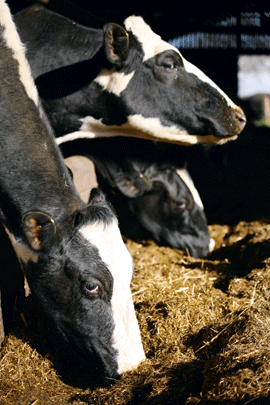Don’t wait too long for soya bean

Non-feed related factors have dominated recent market movements, and substantial sell-offs by investment funds – which have exited the feed commodities – have caused prices to fall.
US wheat futures dropped sharply, while soyabean meal futures tumbled to a six-month low, falling $65/t since 30 August to trade at $320/t at time of writing.
It created a solid opportunity to buy forwards for the winter, and even to consider covering some feeds for summer 2012.
However, this downward movement goes against the fundamental tightness of supply versus demand, particularly for proteins, and is driven predominantly by concerns over global economic stability. The funds have withdrawn quickly from perceived ‘risky’ commodities, but as soon as any hint of confidence returns to the market, reinvestment could drive any rebound rapidly towards higher levels.
As long as soyabean meal remains below £280/t (currently around that level for October-January delivery), keep working to buy in the dips and secure 50-75% of winter requirements now. Nationally, there’s still a lot of protein meal to be bought for the winter, so demand is expected to strengthen at some point in the near future. Don’t get caught out by waiting too long.
Rapemeal also moved downwards, and remains competitively priced against soyabean meal. The European oilseed rape crop was larger than previously predicted, helping confidence in the market, while good supplies of sunflower seed in mainland Europe – plus distillers’ grains from the US and Europe – will help soften any rally.
There’s also an opportunity opening up for summer 2012. This year’s high oilseed rape price encouraged a surge of extra planting, and rapemeal contracts for August-October delivery have dropped to about the mid-£150s/t. Consider booking perhaps 25-50% cover if this looks good value.
But above all else, keep in mind that the fundamentals suggest there’s still a genuine possibility that soyabean meal prices could rise to above £300/t again before the end of the winter. Holding out for contracts below £270/t is a huge risk when compared to a possible £320/t fund-driven rebound.
In contrast, wheat prices have been relatively stable over the past two months, with November 2011 futures only dropping below a steady £160-165/t on five occasions, each time dipping into the £150s/t only briefly before market support moved it back into the £160s/t. There may have been dry weather in the UK, the US and parts of mainland Europe, but global stocks appear large.
A good crop in Australia will add supply to the global market, while Russia continues to snap up most of the export contracts on offer, leaving an export surplus in the US and Europe that will help keep prices down. The International Grain Council (IGC) is also forecasting a higher global wheat production than previously expected, at 679 million t, up from a previous estimate of 677m t and a 2010-11 crop of just 651m t.
With global economic gloom threatening to reduce foreign demand, prices could ease back further, though there’s considerable support coming from a lower-than-expected corn yield in the US. Price trends will become clearer as the US corn harvest nears completion towards the middle of October, but the current stock-to-usage ratio is down to 5%.
That’s just three weeks of global stock in hand, so either corn needs to increase in price to reflect the reduced supply, or potential buyers will switch to wheat, a move that will support the wheat market. Budget on the late £150s/t to mid £160s/t for wheat this winter.
Other energy feeds have come down in line with wheat movements, with some now worth considering. Biscuit meals in the early £170s/t delivered are a good deal for the winter, as are processed bread (late £120s/t, subject to availability). Start to build up to 50% cover on these products while the wheat price holds below £160/t.
Demand for fibres is strong following the dry weather experienced by some areas earlier in the year, which produced poor grass yields and inconsistent forage stocks. British sugar beet feed, and other fibres, remain good value, so cover up to 75% now while well-priced against cereals.
Feedwatch
